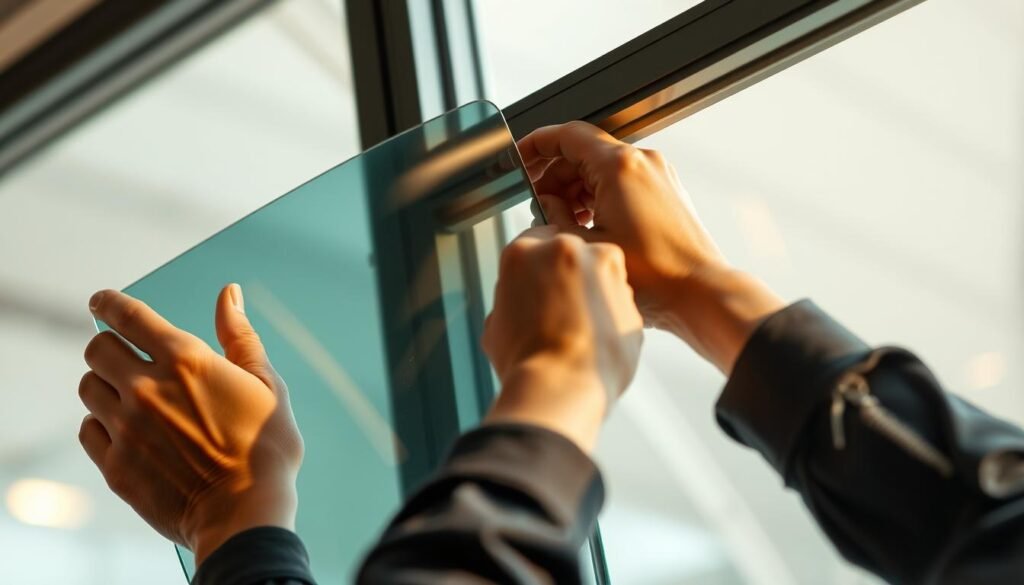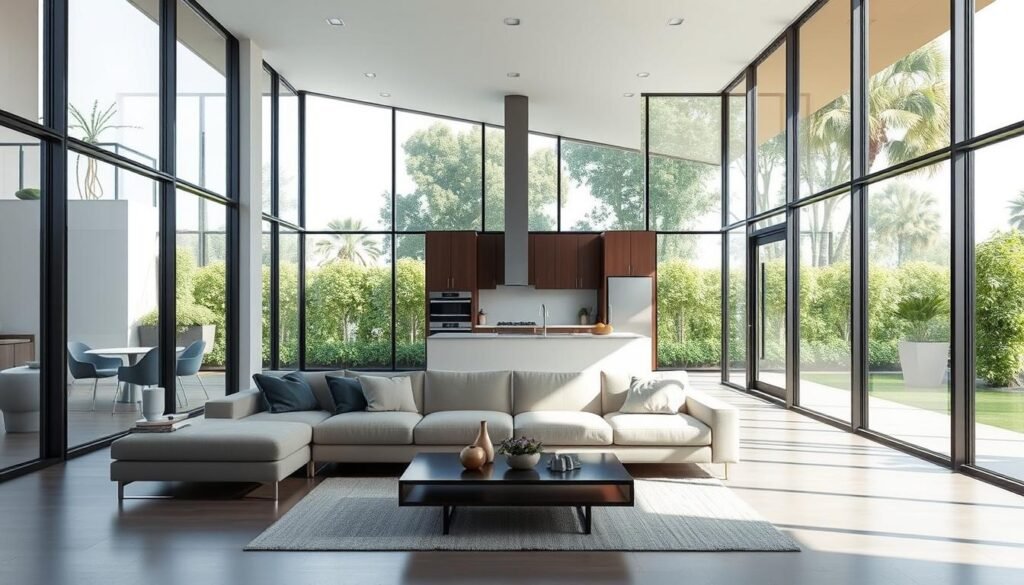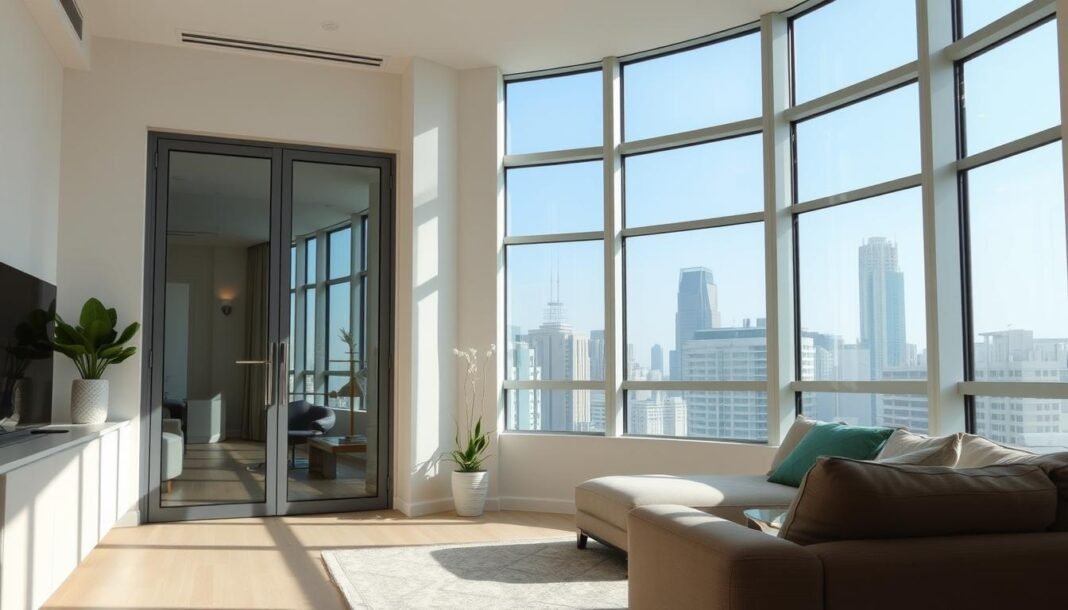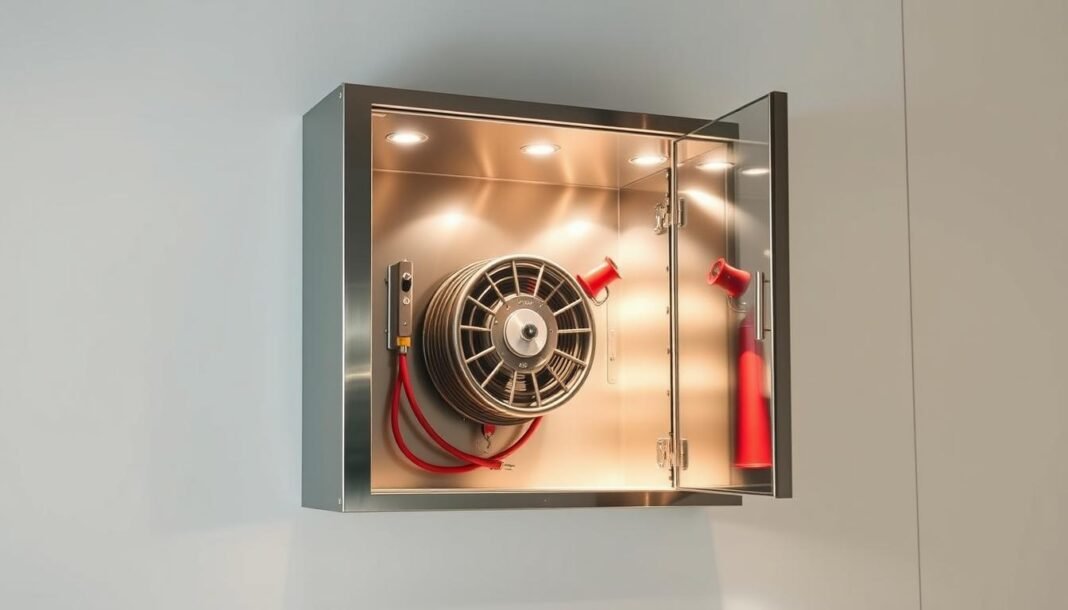Want to make your Singapore home modern and tech-savvy? Electrochromic glass is the answer. It changes how much light it lets in, giving you control over privacy and energy use. This smart glass is changing homes in Singapore, making them brighter and more energy-efficient.
Picture glass that changes from clear to dark with just a touch. This tech combines style with practicality. In Singapore, people are using it to make their homes more comfortable and save on bills. It fits perfectly into any home, from bright balconies to sleek kitchens.
Key Takeaways
- Electrochromic glass Singapore adapts window transparency with smart glass technology.
- Modern home innovation like this enhances privacy and energy efficiency without sacrificing style.
- Automated light control improves comfort in spaces like living rooms and offices.
- Reduces reliance on blinds or curtains while maintaining aesthetic coherence.
- Popular among homeowners seeking sustainable and tech-driven living options.
Understanding Electrochromic Glass Technology
Electrochromic glass is more than just a window. It’s a smart solution for homes in Singapore. This material changes transparency with a simple switch, blending style with function.
How It Works
The heart of smart glass functionality is a thin electrochromic layer between glass panes. A small electric charge causes a chemical reaction. This changes the glass from clear to tinted.
- A low-voltage current flows through the glass.
- Ions move within the electrochromic layer, altering opacity.
- Users control settings via a remote, app, or sensor-based automation.
Key Advantages
The benefits of electrochromic glass go beyond looks. Here are the main advantages:
- Blocks 99% of UV rays, protecting furniture and health.
- Reduces glare while maintaining natural light flow.
- Cuts energy costs by lowering air-conditioning demand.
| Feature | Regular Glass | Electrochromic Glass |
|---|---|---|
| UV Protection | Minimal | Full UV blocking |
| Light Control | Requires blinds/shades | Automatic tint adjustment |
| Energy Use | High heat gain | Cuts cooling costs by 15–20% |
Benefits for Singapore Homes
Electrochromic glass brings Singapore home benefits that fit the city-state’s climate and lifestyle. It changes spaces to meet daily needs, from managing sunlight to saving energy.
Enhanced Light Control
Electrochromic glass offers light control innovation. It changes window tint with just a touch. This is better than fixed blinds because it lets in the right amount of natural light and cuts glare.
It’s perfect for sunny Singapore. It reduces the need for artificial lighting and keeps homes cool.
Privacy and Security
Switch between clear and opaque with a touch for enhanced privacy. Forget bulky curtains—glass partitions can divide or shield spaces without losing style. Koble’s smart systems work with home automation for easy, secure privacy.
Energy Efficiency
Energy-saving glass cuts down on air-conditioning use by blocking heat. In hot climates, it lowers utility bills and carbon emissions. Unlike regular windows, it keeps room temperatures steady, making it a green choice for eco-friendly homeowners.
Exploring Design Possibilities
Electrochromic glass brings new ideas to innovative glass design in Singapore homes. Architects and homeowners can mix function and style easily. It works for everything from floor-to-ceiling partitions to sleek room dividers.
Imagine windows that change from clear to tinted with just a tap. This is perfect for spaces that need flexible light control without losing beauty.
- Dynamic partitions for open-plan layouts
- Privacy-adjustable office nooks within homes
- Accent walls that transition between clear and opaque
Smart home aesthetics get a boost with electrochromic glass and tech like voice assistants. A living room with tinted glass walls can change from bright to cozy with a tap. Luxury condos in Singapore show how it’s used in top design.
Designers love its flexibility: “This material changes how we use light and space,” says a top Singapore interior studio. With so many ways to customize, electrochromic glass makes every home unique and on-trend.
Installation and Maintenance Tips
Electrochromic glass makes homes look great. But, it needs the right setup and care. Follow these tips for long-lasting, top-notch performance.

Professional Installation Advice
Choose professional installation to avoid mistakes. Find certified techs who know smart glass systems. Ask for their past work and references.
- Check warranties and guarantees before you sign.
- Make sure they follow local building codes for safety.
Routine Maintenance Practices
Keep your glass clear and working well with these glass maintenance tips:
- Clean with soft cloths and gentle cleaners.
- Check electrical connections every few months to avoid problems.
Troubleshooting Common Issues
Fix small problems fast with these troubleshooting smart glass tips:
| Issue | Solution |
|---|---|
| Slow tinting | Check the power supply and adjust controls. |
| Streaky look | Use a microfiber cloth and distilled water to clean. |
Regular care and quick fixes keep things running smoothly. For big problems, call in the experts.
Customization & Integration Options
Electrochromic glass is more than just a feature—it’s a way to express your style. Custom smart glass fits any look, from simple to bold. You can pick colors, transparency, or frames to match your home perfectly. Every home is unique, so why choose something generic?
There are many ways to integrate your glass. You can use voice commands, motion sensors, or light sensors for home automation integration. Imagine windows that change color when it gets too bright or adjust on their own at sunset. These features work with Apple HomeKit or Samsung SmartThings, making your life easier.
- Control via smartphone apps for real-time adjustments
- Sync with existing lighting and HVAC systems
- Pre-set schedules for energy-efficient routines
Whether you’re updating an apartment or building a new home, custom smart glass fits your needs. Architects in Singapore often suggest it for its versatility. Choose systems that combine style and technology, where creativity meets your personal taste.
Innovative Trends in Home Technology
Home tech trends in Singapore are moving towards seamless device integration. This includes electrochromic glass with other smart systems. New technology is making homes more intuitive, combining comfort with green living. Let’s see how these changes are shaping our living spaces.
Smart Home Synergies
Now, smart home systems link electrochromic glass with voice assistants and climate control. Brands like Koble show this with systems that adjust lighting and privacy settings on their own. For example, windows can darken when it’s too bright, saving energy without needing to be told.
Emerging Market Trends
Market data shows a growing need for connected devices. Here are the latest trends:
- Automated climate control paired with smart windows
- AI-driven energy management systems
- Increased use of voice-command interfaces
| Trend | Adoption Rate in Singapore (2023) |
|---|---|
| Smart lighting systems | 68% |
| Automated climate control | 55% |
| AI home assistants | 45% |
These numbers show people want homes that adapt to their needs. As technology advances, expect electrochromic glass and home automation to work even closer together.
Unveiling the Science of Electrochromic Glass
Electrochromic glass changes spaces with new glass composition and engineering. It uses layers that change with electricity. Scientific insights show it works well in Singapore’s humid weather.
“Electrochromic materials adapt seamlessly to environmental changes, ensuring consistent performance over time.”
Composition & Mechanism
The electrochromic mechanism has thin coatings between glass. It includes:
- Electrochromic layers that tint when charged
- Transparent conductors to distribute electricity evenly
- Ion storage layers for sustained color changes
Durability Factors
Smart glass lasts long because of its materials. Important factors are:
| Factor | Impact |
|---|---|
| UV Resistance | Protects against fading |
| Temperature Range | Handles Singapore’s heat |
| Mechanical Stress | Withstands daily use |
| Chemical Exposure | Resists moisture and pollutants |
Brands like SageGlass test their glass composition for over 10,000 tint changes. This shows they last long. Their design ensures smart glass works well without losing function.
Expert Tips for Smart Home Upgrades
Turning your Singapore home into a smart home begins with making smart choices. Expert home tech tips from leaders like Koble can guide you through upgrades like electrochromic glass. Here’s how to focus on quality provider selection and design consultation for great smart home upgrades.

“A well-planned design consultation bridges technology and lifestyle needs.” – Koble Smart Solutions Team
Choosing the Right Provider
Seek out certified installers with electrochromic system experience. Ask for references and check for ISO 9001 certifications. Choose companies like Koble, known for their 5-star rated service in Singapore.
- Verify provider warranties (minimum 5 years for glass components)
- Request case studies of similar smart home projects
Design Consultation Insights
Work with designers who know how to integrate electrochromic glass. A good design consultation makes sure systems fit well with:
| Aspect | Key Consideration |
|---|---|
| Lighting | Compatibility with existing smart lighting systems |
| Privacy | Automatic tinting schedules for different rooms |
| Energy | Integration with solar panels or HVAC systems |
Upgrading with electrochromic glass and energy management tools can save a lot. Koble’s projects have seen 20–30% energy cost cuts. Begin by checking your home’s current tech setup to find what’s missing.
electrochromic glass singapore: A Smart Investment
Electrochromic glass is more than a luxury—it’s a smart investment for homeowners in Singapore. Let’s look at the cost analysis and the long-term benefits of this technology.
The initial cost might seem high, but the ROI of smart glass is clear. It saves on energy and increases your home’s value. Here’s why:
- Energy bills drop 20-30% by using less AC and lighting
- Resale value goes up by 5-10% with smart glass
- It’s easier to maintain than traditional windows
“Electrochromic systems pay for themselves in 5-7 years through energy savings alone.”
When you think about investment in home technology, consider the long-term gains. Homes with View Dynamic Glass save S$2,500 a year on utilities. It also saves money on blinds or heavy curtains.
Smart glass adjusts its tint to reduce glare and keep views open. It’s a smart choice for families who want comfort and savings. This upgrade brings real benefits without losing style.
Environmental Impact and Sustainability
Eco-friendly glass solutions like electrochromic windows are changing how Singapore homes help the planet. These smart systems adjust to sunlight automatically. This cuts down on energy needed for lighting and cooling, tackling environmental issues head-on.
This innovation fits right into Singapore’s goal for greener living. It brings real environmental benefits to our homes.
Smart design choices are key to reducing a home’s carbon footprint. Electrochromic glass uses less power, which means fewer greenhouse gases. Studies show these upgrades can cut a household’s energy use by 15-25%.
This makes them a vital part of sustainable living.
Reducing Carbon Footprint
- Automated light management cuts down on artificial lighting and air conditioning needs. This can save up to 20% in energy use.
- Less energy use means fewer emissions from power plants. This directly lowers a home’s carbon footprint.
Eco-friendly Benefits
Electrochromic glass is made to last, reducing waste over time. Its durable design means fewer replacements are needed. Many manufacturers now offer recyclable materials, boosting sustainability.
For example,
“Electrochromic systems reduce lifecycle emissions by 45% compared to conventional windows,”
states a 2023 report by the Singapore Green Building Council.
Choosing eco-friendly glass is more than just saving money today. It’s a step towards meeting Singapore’s 2030 Green Plan goals. By focusing on carbon footprint reduction, homeowners can make their spaces cleaner without giving up modern comforts.
Future Innovations in Home Building
Technology is changing how we live, making homes smarter and more adaptable. Future home building is blending with smart building trends to create homes that adjust to our needs. With the help of AI and sustainable materials, the next homes will be both intelligent and eco-friendly.
Emerging Technologies
Homes are becoming more independent thanks to new tech. Some key advancements include:
- AI-powered climate systems that adjust lighting and ventilation based on occupancy and weather.
- Self-healing concrete and biodegradable insulation materials reducing long-term waste.
- Wireless charging floors and voice-activated security systems integrated into modern architecture designs.
Modern Architectural Trends
Designers are now focusing on both form and function. New styles include:
- Vertical urban farms integrated into apartment walls for fresh produce year-round.
- 3D-printed homes cutting construction time by 50% while using recycled materials.
- Transparent solar panels replacing traditional windows to generate clean energy.
“By 2030, 60% of new builds in Singapore will incorporate smart building trends, per the Urban Redevelopment Authority’s 2024 report.”
These changes show a clear direction toward homes that value both technology and nature. As emerging innovations become common, our living spaces will transform into dynamic ecosystems. They will improve our daily lives and protect the environment.
Conclusion
Electrochromic glass is leading the way to smarter living in Singapore. It combines innovation with style, offering benefits like adjustable light and energy savings. For homeowners, it’s more than just windows—it’s a step into the future of smart homes.
This upgrade helps reduce energy bills and boosts design flexibility. It aligns with Singapore’s goal for sustainable, tech-driven spaces. It shows how this change supports both environmental goals and modern looks.
Choosing electrochromic glass is a smart move for long-term comfort and efficiency. It fits with the trend of using eco-friendly materials in architecture. Whether you’re upgrading or building a new home, this tech makes spaces adaptable to changing needs.
Electrochromic glass is easy to integrate into smart systems and is very durable. It’s a key feature for future-ready homes in Singapore. For those who want to balance style, sustainability, and smart living, this innovation is a great choice. Start exploring today to see how cutting-edge tech meets timeless design.



